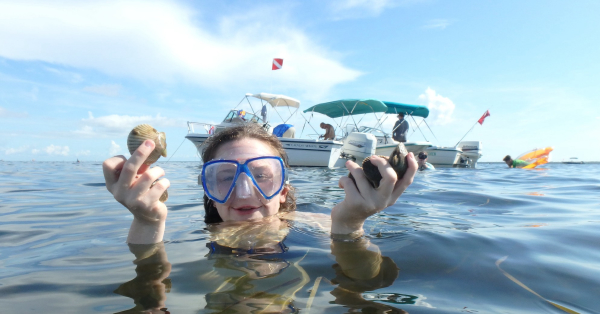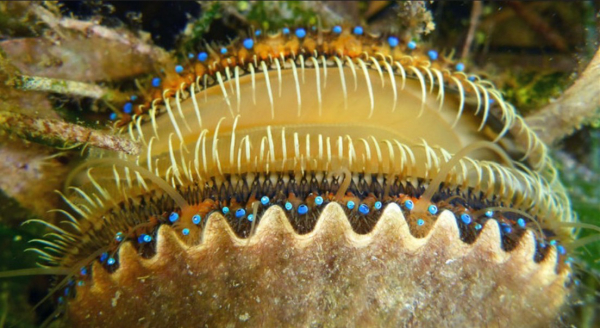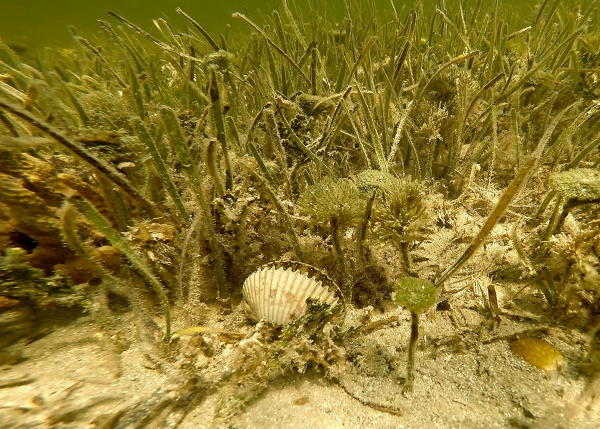
Diving for bay scallops has become a huge attraction on Florida’s Gulf Coast in recent years, with thousands enjoying the abundance in areas where conditions are right. (Florida FWC)
Look for blue eyes peeking from the sea grass on Florida’s Gulf Coast and you’ll get a quick read of the health of the local fishery. Bay scallops—short-lived, grass-bed creatures with a one-year life cycle—respond fast to changes in water clarity, salinity, and seagrass coverage. (They do, in fact, have what look like blue eyes all around the rim of their open shell.)
When water quality declines, scallops fade; when water clears and grass rebounds, they can bloom in a single season. That sensitivity makes them the canaries in the coal mine for water quality and submerged aquatic vegetation (SAV) along Florida’s west coast.
Why scallops tell the truth
FWC scientists have long tied scallop abundance to environmental drivers: salinity swings from floods or droughts, harmful algal blooms, and, most importantly, the extent and health of seagrass. Because bay scallops live only 12–18 months, their numbers track recent conditions, not ancient history.
They rise and fall in broad 5–7-year cycles and can swing from near-zero to robust in a season. That variability was so pronounced that FWC recently discontinued its pre-season abundance survey in favor of post-season assessments that better reflect spawning stock and habitat condition—another sign of just how tightly scallops are linked to real-time estuary health.
In the last decade—since the takeover of Facebook from conventional media—scallop diving has gone from being an arcane, local tradition to a massive tourist attraction, with thousands of divers swarming to prime areas when the late summer seasons are open.
The driving force is taking home the makings of a very tasty seafood treat, but looked at that way scalloping is way more trouble than it’s worth for the tiny bits of meat bay scallops produce—it’s far more a family celebration of Florida’s remarkable Gulf Coast and the productivity of healthy water.
Healthy scallop water is trout and redfish water
The same recipe that grows scallops—clean, clear water over lush grass—also grows seatrout, redfish, snook and a laundry list of inshore species. Seagrass beds filter nutrients, trap sediment, and stabilize bottoms, improving clarity while providing food and structure for juvenile and adult fish.
South to north: recent trends from Sarasota Bay to St. Joseph Bay
Sarasota Bay. Scallops here are effectively at “remnant” levels, with citizen science carrying much of the monitoring load. Recent samplings suggest low but flickering recruitment: Little Sarasota Bay spiked from zero spat in 2023 to a dozen spat in 2024 at one collector site—encouraging, but a far cry from a fishable stock. Annual volunteer “Great Scallop Search” events continue to map where scallops—and the seagrass that sustains them—are hanging on.
Tampa Bay & adjacent waters. Historically a seagrass-recovery success, Tampa Bay has seen a recent reversal, with a roughly 28% loss in seagrass between 2016 and 2022. Scallops, already sparse, struggle to re-establish when grass thins and turbidity rises—which is why biologists emphasize cutting nutrient loads and protecting SAV. For anglers, those same trends often translate to tougher trout and redfish fishing on former “salad bar” flats.
Nature Coast/Big Bend (Citrus–Levy–Taylor). From Homosassa to Keaton Beach, the story brightens. Extensive, shallow grass meadows and generally clear water still support reliable recreational scalloping, though year-to-year swings are normal. FWC notes these central grounds—“Citrus” and “Dixie-Taylor”—remain stable enough to sustain a fishery in most seasons, a testament to the scale and quality of Big Bend seagrass.

Scallops open their shells to filter feed, revealing their blue “eyes”. They’re only found in areas with healthy sea grass and clear water. (Florida FWC)
St. Joseph Bay. Farther west, St. Joe took a major hit from a 2015 red-tide event that drove emergency closures and an intensive restoration push using hatchery and locally collected brood stock. The good news: monitoring has shown improvement since the crash, and restoration continues as managers nurse the bay toward self-sustaining levels. That recovery arc—down hard with HABs, then back with clean water, grass protection, and careful harvest—illustrates the scallop-as-indicator theme as clearly as anywhere on the coast.
What scallops want (and what anglers can do)
Scallops need:
- Clear water: low nutrients, low turbidity.
- Right-range salinity: not hammered by prolonged freshwater pulses.
- Intact seagrass: especially shoal grass and turtle grass meadows in 4–10 feet.

Sea grass is a key element in scallop abundance, just as it’s an indicator of good flats fishing for redfish, trout and other species. (Florida FWC)
Those are exactly the conditions that make a flat come alive with popping trout, tailing reds, cruising snook, and clouds of bait. Protecting them pays off twice—first in a sustainable summer scallop season and again in year-round inshore fishing. Practical steps? Mind fertilizer and stormwater on land; idle in skinny grass to prevent prop scars; keep harvest conservative when a bay’s clearly rebuilding; and support local monitoring.
The take-home for anglers
Bay scallops are honest storytellers. When you see plenty of grass and scallops from Citrus to Taylor counties, odds are you’ll also see speckled trout popping and redfish pushing wakes on the same flats. When Sarasota’s counts barely register and Tampa Bay’s grass contracts, expect tougher inshore fishing and more boom-bust patterns until water quality turns. Keep an eye on the scallops; they’ll keep you ahead of the bite—and remind all of us that the best fishery management often starts far upstream, where clearer water and healthier grass begin.
— Frank Sargeant
Frankmako1@gmail.com